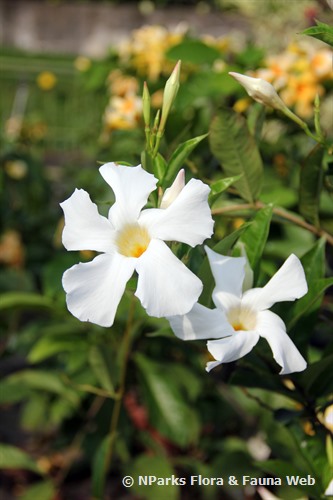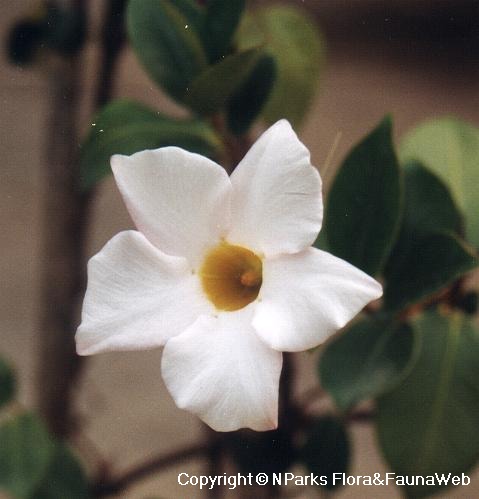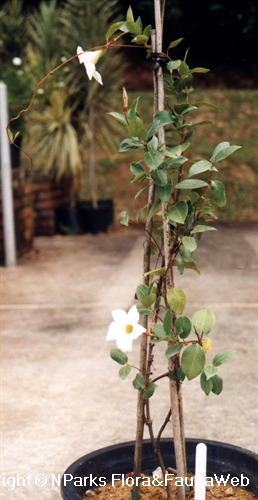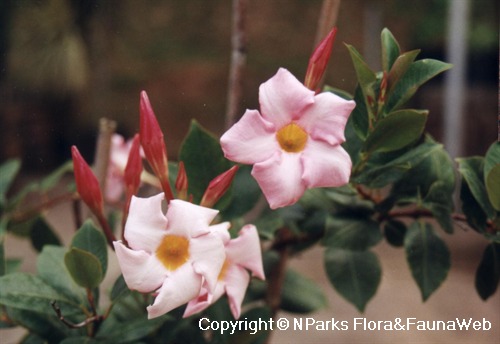.jpg)
Back
Mandevilla sanderi 'My Fair Lady'
| Family Name: | Apocynaceae |
| Synonyms: | Dipladenia sanderi 'My Fair Lady' |
Name
Classifications and Characteristics
| Plant Division | Angiosperms (Flowering Seed Plants) (Dicotyledon) |
|---|---|
| Plant Growth Form | Climber |
| Lifespan (in Singapore) | Perennial |
| Mode of Nutrition | Autotrophic |
| Plant Shape | Irregular |
Biogeography
| Native Distribution | South Brazil |
|---|---|
| Native Habitat | Terrestrial |
| Preferred Climate Zone | Tropical |
| Local Conservation Status | Non-native (Horticultural / Cultivated Only) |
Description and Ethnobotany
| Growth Form | A woody vine that spreads up to 2.5 m. |
|---|---|
| Foliage | Deep green leaves, lance-shaped. Leaves are arranged oppositely along the stems, and produce milky sap when broken. |
| Flowers | Flowers are white, tubular or funnel shaped, with 5 spreading petals and yellow throat. They occur singly or in clusters. Flower buds are pinkish in colour. |
| Cultivation | Plant under full sun with regular watering. Plants can also be planted indoor but with bright light. Pinch the shoots to promote bushiness. Plant requires support to allow climbing. |
| Etymology | The genus Mandevilla is named after Henry John Mandeville, a diplomat in Buenos Aires who introduced Chilean jasmine. The specific epithet sanderi is named after Henry Frederick Conrad Sander and family, nurserymen of St. Albans and Bruges, importers of many new plants. |
Landscaping Features
| Desirable Plant Features | Ornamental Flowers |
|---|---|
| Landscape Uses | Parks & Gardens, Small Gardens, Trellis / Arbour / Pergola, Container Planting |
Fauna, Pollination and Dispersal
| Fauna Pollination Dispersal Associated Fauna | Butterfly-Attracting |
|---|
Plant Care and Propagation
| Light Preference | Full Sun |
|---|---|
| Water Preference | Moderate Water |
| Plant Growth Rate | Fast |
| Rootzone Tolerance | Moist Soils, Well-Drained Soils |
| Potential Problems | Mealybugs and aphids. |
| Propagation Method | Division |
Foliar
| Foliage Retention | Evergreen |
|---|---|
| Mature Foliage Colour(s) | Green |
| Mature Foliage Texture(s) | Glossy / Shiny |
| Prominent Young Flush Colour(s) | Green |
| Young Flush Texture(s) | Glossy / Shiny |
| Foliar Type | Simple / Unifoliate |
| Foliar Arrangement Along Stem | Opposite |
| Foliar Attachment to Stem | Petiolate |
| Foliar Shape(s) | Non-Palm Foliage (Lanceolate) |
| Foliar Venation | Pinnate / Net |
Floral (Angiosperm)
| Flower Colour(s) | White |
|---|---|
| Flower Grouping | Solitary, Cluster / Inflorescence |
| Flower Symmetry | Radial |
| Individual Flower Shape | Funnelform / Funnel-shaped, Tubular |
| Inflorescence Type | Umbel |
Image Repository
Others
| Master ID | 150 |
|---|---|
| Species ID | 1446 |
| Flora Disclaimer | The information in this website has been compiled from reliable sources, such as reference works on medicinal plants. It is not a substitute for medical advice or treatment and NParks does not purport to provide any medical advice. Readers should always consult his/her physician before using or consuming a plant for medicinal purposes. |

.jpg)




.jpg)
.jpg)